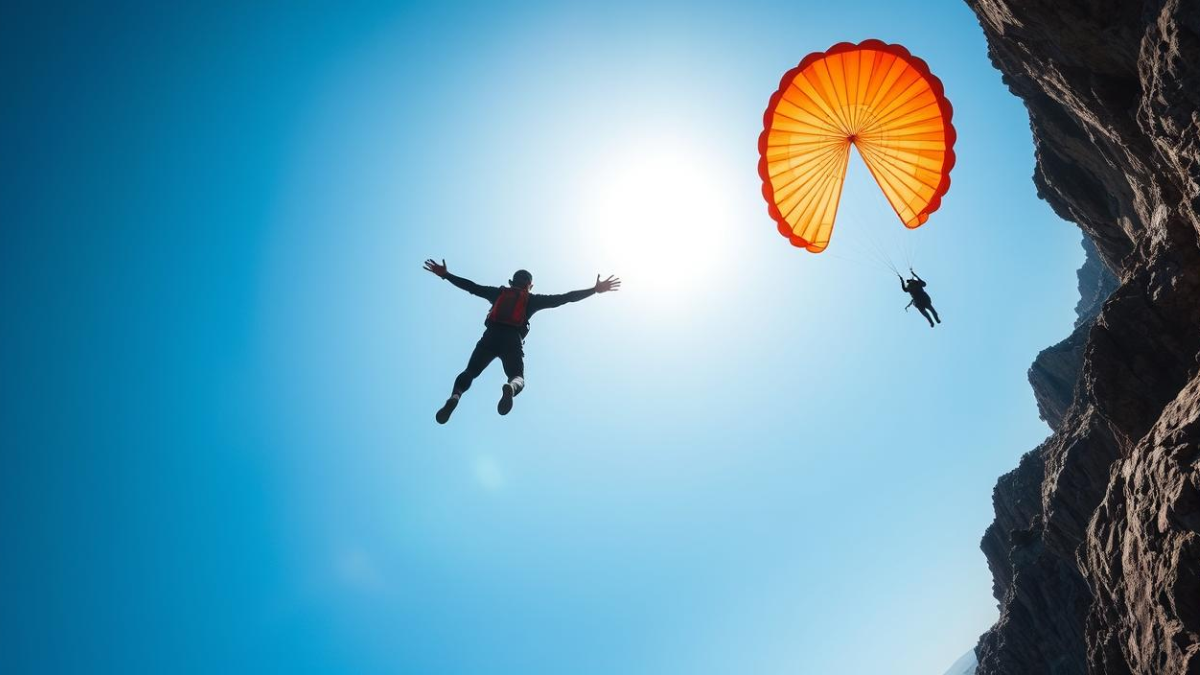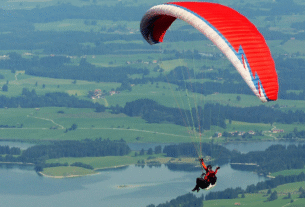Introduction
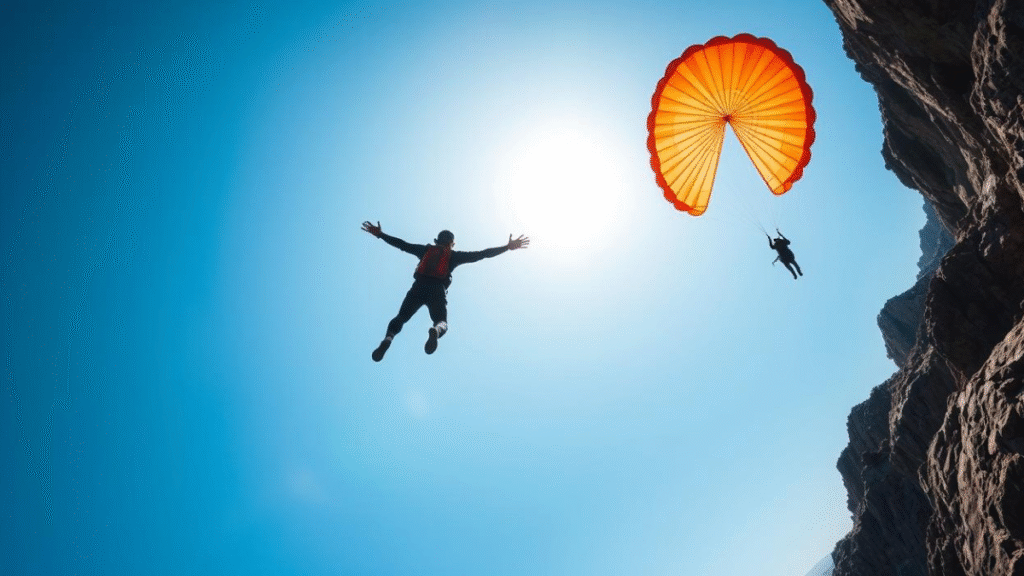
Ever wondered how it feels to leap off a cliff, bridge, or skyscraper with nothing but a parachute? What is BASE Jumping? BASE jumping pushes the limits of adventure, blending adrenaline with precise skill.
This thrilling activity is not just about the jump; it requires extensive knowledge of the environment, weather conditions, and the mechanics of freefall. Unlike traditional skydiving, which typically involves jumping from higher altitudes with more time to deploy a parachute, this extreme sport demands split-second decisions and specialised gear.
The proximity to the ground means that jumpers must react quickly to any unexpected changes, making it essential to have a solid grasp of the techniques involved in safe landings and navigation through the air. Additionally, BASE jumping often takes place in breathtaking but challenging locations, further amplifying the need for thorough preparation and practice.
Despite its risks, the sport attracts thrill-seekers worldwide. From Norway’s towering fjords to Dubai’s urban landscapes, iconic locations offer unforgettable drops. However, success hinges on training, preparation, and adherence to safety protocols.
This guide dives into 10 crucial tips for a secure yet electrifying experience. Whether you’re a beginner or refining your technique, mastering these fundamentals ensures confidence in the air.
Key Takeaways
- BASE jumping differs from skydiving in that it involves lower altitudes and faster reactions.
- Proper training from certified organisations like the USBA is non-negotiable.
- Iconic global spots offer unique challenges for experienced jumpers.
- Misconceptions about required experience can lead to dangerous mistakes.
- Safety gear and pre-jump checks are critical for every attempt.
What is BASE Jumping? Defining the Extreme Sport
Carl Boenish’s 1978 coinage of the term marked a new era in aerial adventure. The *acronym*—Buildings, Antennas, Spans (bridges), and Earth (cliffs)—reflects the fixed objects jumpers launch from.
These locations, which vary significantly in height and structure, offer a unique backdrop for the sport, providing breathtaking views and exhilarating experiences. Unlike skydiving’s aircraft exits, these structures demand instant decision-making.
Each jump requires a deep understanding of the environment and the physics involved, as jumpers must assess wind conditions, landing zones, and potential obstacles to ensure a safe and successful jump. This heightened level of awareness and skill distinguishes BASE jumping from traditional skydiving, adding to its appeal and challenge.
The Origins and Meaning of the BASE Acronym
Boenish, a filmmaker and skydiver, pioneered the sport by documenting leaps off El Capitan. His groundbreaking work not only captured the breathtaking visuals of these daring jumps but also formalised the *acronym* and established essential safety protocols that are crucial for the sport’s integrity.
Today, organisations like the USBA uphold these standards, ensuring that safety remains a priority for all participants and that the sport continues to grow responsibly.
Launch heights range from 150 to 2,000 feet—far lower than skydiving’s 10,000+ feet. This means free-falls last mere seconds, intensifying the thrill and the need for precise timing.
Urban objects, such as Kuala Lumpur’s Petronas Towers, introduce legal complexities that can deter some thrill-seekers. The unique challenges of navigating city regulations and potential legal repercussions add another layer of excitement and risk to urban jumps, making them particularly appealing to experienced jumpers who thrive on pushing boundaries.
Capturing the Thrill-Seeker’s Spirit
The sport’s allure lies in its raw unpredictability. A 5-second drop from Norway’s Kjeragbolten cliff delivers an unmatched adrenaline rush, as the sheer force of air and the breathtaking views create an exhilarating experience that few can replicate.
Each jump is a unique encounter with nature’s elements, where factors like wind speed and weather conditions can drastically alter the outcome. Communities celebrate this daring culture through events like Bridge Day in West Virginia, where thousands gather to witness and participate in the thrill of BASE jumping, fostering a sense of camaraderie among enthusiasts.
Preparation is rigorous and essential for safety. Unlike tandem skydiving, becoming a *jumper* requires months of dedicated training, where aspiring jumpers learn not only the technical aspects of the sport but also how to handle emergencies and unexpected situations.
Mentorship from groups like APEX BASE ensures newcomers respect the sport’s risks and rewards, guiding them through practical experiences and theoretical knowledge that emphasises the importance of safety protocols and risk management in high-stakes environments.
BASE Jumping vs. Skydiving: Key Differences Explained
While both sports involve parachutes, the contrasts between them redefine adventure. From altitude to gear, each element demands unique skills and mindsets.
For instance, skydivers must master the art of free-fall stability and body positioning during descent. In contrast, BASE jumpers focus on quick decision-making and precise landing techniques due to their significantly lower jump heights.
Additionally, the gear used in each sport varies greatly; skydivers typically utilise larger parachutes designed for slower descents, while BASE jumpers opt for smaller, more manoeuvrable canopies that allow for rapid deployment and agile landings.
Altitude and Freefall Time: A Dramatic Contrast
Launch heights reveal the starkest difference. Skydivers exit planes at 10,000+ feet, enjoying 60-second freefalls that provide ample time for manoeuvring and stabilising their bodies in the air.
This altitude allows them to experience the thrill of freefall before deploying their parachutes, making for a longer and more exhilarating descent. In contrast, fixed objects average 92% lower, just 150–2,000 feet, which drastically alters the dynamics of the jump.
“BASE freefalls last 3–8 seconds. Every millisecond counts,” notes veteran instructor Jake Smith. This compressed time window demands instant canopy deployment, as jumpers have only moments to react and ensure a safe landing.
The brief duration of the freefall leaves little room for error, requiring BASE jumpers to have honed reflexes and precise control over their parachutes.
Landing Areas and Environmental Challenges
Landing areas shrink from football fields to parking spots; choosing a landing site is critical for safety and precision. Urban jumps often feature obstacles, such as power lines, buildings, and other structures, that can complicate the landing process.
At the same time, cliffs may present uneven terrain and varying wind patterns that can be challenging to navigate. Wind gusts become particularly critical at low altitudes, as they can significantly impact a jumper’s trajectory and stability during the final approach.
Skydivers benefit from open drop zones that are specifically designed for safety and ease of landing. These zones are typically expansive, allowing for a range of landing options and minimising the risk of collisions.
Tandem skydiving often uses designated areas with ground crews to assist in landing and recovery, ensuring that jumpers have support upon touchdown. In contrast, BASE relies on solo scouting—a skill honed over months, where jumpers must meticulously assess potential landing sites and account for various environmental factors that could impact their descent.
Equipment Variations: One Parachute vs. Reserve Systems
Skydivers typically use dual parachutes, consisting of a main and reserve parachute. This dual system is crucial for safety, as it provides a backup in case the main parachute fails to deploy correctly.
The reserve parachute can be deployed at higher altitudes, giving skydivers the luxury of time to manage their descent. One parachute dominates BASE due to its impracticality at low altitudes.
In this extreme sport, jumpers rely on a single parachute that must open quickly and efficiently to ensure a safe landing. Specialised canopies feature faster openings and tighter turns, designed specifically for the short distances involved in BASE jumps, where every second counts.
Reserves require 800+ feet—most jumps don’t have that luxury. This limitation means that BASE jumpers must have absolute confidence in their main parachute, as there is little room for error.
Harnesses also differ significantly between the two sports. BASE rigs prioritise quick releases, allowing jumpers to detach from their parachute swiftly in emergencies, while skydiving containers focus on stability during longer descents.
The design of these harnesses reflects the distinct demands of each activity, ensuring that jumpers are equipped to handle the unique challenges they face in the air.
The Risks and Realities of BASE Jumping
Statistics reveal a stark truth: this adventure demands more than courage—it requires precision. With a fatality rate of 1 in 2,300 jumps—compared to skydiving’s 1 in 100,000—the stakes are undeniably higher. Proximity to objects and rapid decision windows amplify the risk.
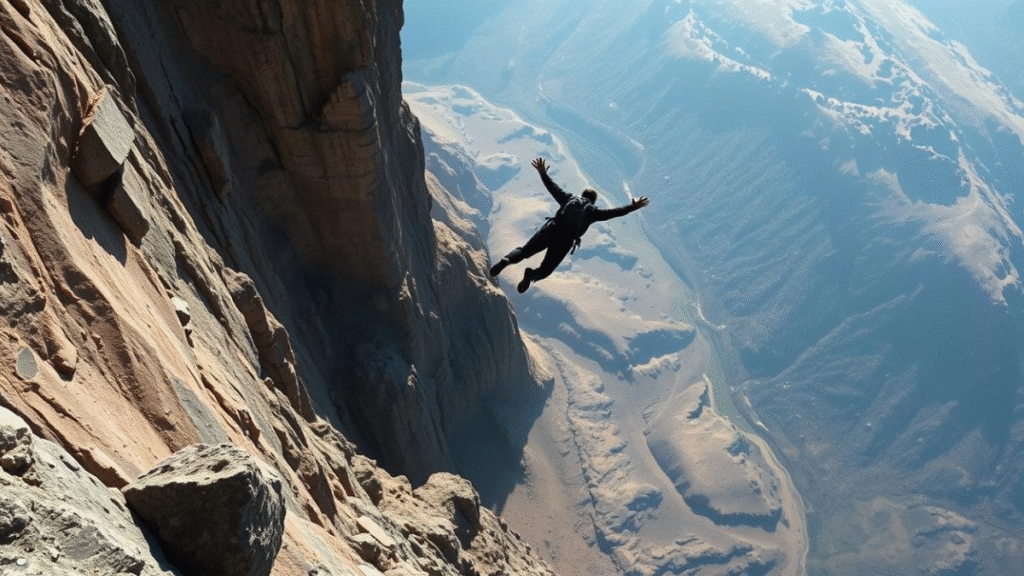
Why This Sport is Considered More Dangerous Than Skydiving
Low altitudes leave no room for error. A 0.5-second delay in deploying a parachute can be catastrophic, leading to dire consequences that can result in serious injury or even death.
Unlike skydivers, base jumpers lack automatic activation devices, which are designed to deploy a parachute if the jumper fails to do so promptly.
Their equipment is streamlined for speed, not redundancy, meaning that every second counts and the margin for error is razor-thin, requiring absolute precision and quick reflexes.
Seasonal factors add complexity to the already risky endeavour. Winter jumps introduce icy surfaces that can lead to dangerous landings, while summer winds can destabilise canopies, causing unpredictable flight paths and increasing the risk of collisions with obstacles.
A study from *Extreme Sports Medicine* found a 40% higher incidence of severe trauma compared to skydiving, underscoring the unique hazards faced by BASE jumpers in varying weather conditions.
Common Misconceptions About Safety
“Many assume skydiving experience guarantees success here,” says instructor Lara Kessler. Transitioning requires 200+ skydives and mentorship, not just technical skill. Overconfidence is a contributing factor in 27% of first-year accidents.
Tracking—a technique to gain distance—is lethal without proper training. No reserve parachute can save you from a misjudged trajectory.
Recent canopy technology has improved safety, but human judgment remains critical. Communities like the USBA stress the importance of rigorous drills for every scenario, even those learned months ago.
Essential BASE Jumping Equipment for Beginners
Gearing up for your first leap? The right equipment makes all the difference. Unlike skydiving, gear here is tailored for low-altitude precision and rapid deployment, which is crucial given the unique challenges of BASE jumping.
Every component—from parachutes to helmets—must meet rigorous safety standards. This includes not only the quality of the materials used but also their design, which is specifically engineered to ensure that jumps are executed safely and effectively.
For instance, the parachutes are designed to open quickly and provide a stable descent, while helmets are crafted to protect against impacts during landing.
Additionally, accessories such as altimeters and audible devices are essential for monitoring altitude and ensuring timely deployments, further enhancing safety and performance in this high-stakes sport.
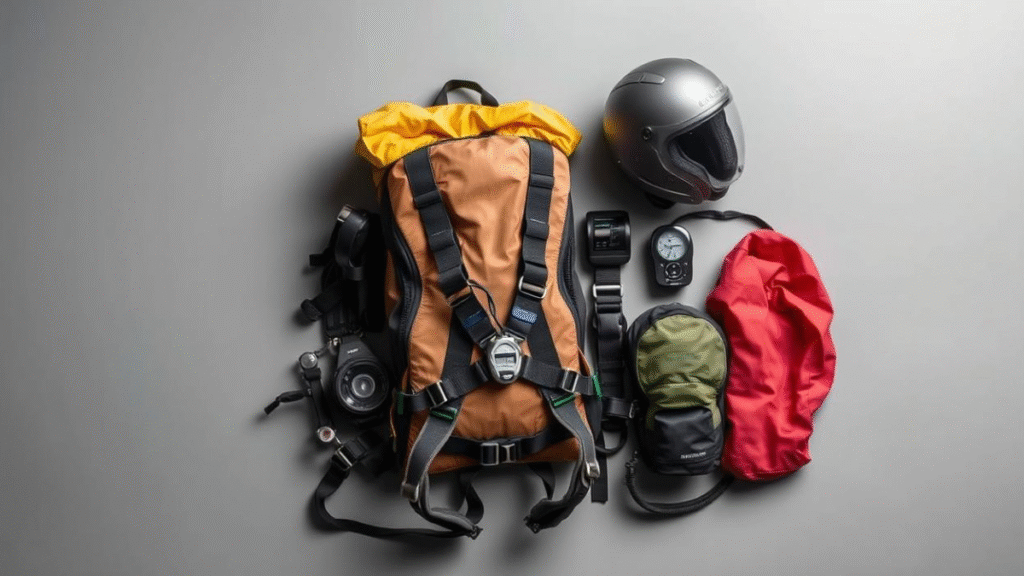
Parachutes and Containers: Specialised Gear for Low Altitudes
Canopies range from 240–300 sq ft, larger than skydiving’s 80–200 sq ft for slower descent. Containers feature quick-access designs, prioritising instant deployment. “A standard rig won’t cut it—delays are fatal,” warns APEX instructor Marco Rossi.
Rigging varies by object. Cliff jumps need steerable canopies, while urban drops require compact packs. Starter kits cost $5,000–$8,000, reflecting specialised materials. Always verify manufacturer certifications, such as those from ICARUS.
Protective Clothing and Accessories
Full-face helmets dominate for impact protection, while boots prioritise ankle support over flexibility. These helmets are designed to absorb significant impact forces, which is crucial in the event of a hard landing or collision with obstacles. Additionally, they often feature visors to protect the eyes from debris and improve visibility during freefall. Essential add-ons include:
- Hook knives for line entanglements, which are vital for quick access in emergencies where lines may become tangled, potentially jeopardising a safe landing.
- Altitude alarms for sub-1,000-foot jumps are designed to alert jumpers of their altitude and ensure they deploy their parachute at the correct height, preventing premature or late deployments that could lead to serious accidents.
- Jump logs track gear wear, allowing jumpers to monitor the condition of their equipment over time and ensure that any wear and tear is addressed before it compromises safety.
Reserve parachutes require repacking every six months; skipping this step voids the warranty. Regular maintenance is essential to ensure that the reserve parachute functions properly in an emergency.
Never modify skydiving gear; mismatched tension can destabilise openings, leading to unpredictable and potentially dangerous deployments that could put the jumper at risk.
Training and Preparation: Your Path to Becoming a BASE Jumper
Mastering the art of free-fall from fixed objects demands disciplined preparation. Unlike recreational skydiving, this journey requires methodical skill-building under certified supervision. Rushing the process jeopardises safety and technique.
Prerequisite Skydiving Experience: How Many Jumps Are Enough?
The U.S. BASE Association mandates 200+ skydiving first jumps before initial training. This number ensures canopy control mastery, which is critical for low-altitude deployments.
The experience gained from these jumps is invaluable, as it helps aspiring BASE jumpers develop a strong understanding of free-fall dynamics and parachute handling.
This foundational knowledge is essential for safely executing jumps from fixed objects, where the margin for error is significantly smaller compared to traditional skydiving.
“First-time jumpers often underestimate wind judgment at 500 feet,” warns USBA instructor Rachel Torres, highlighting the importance of understanding environmental factors that can impact a jump. Without this knowledge, a jumper may miscalculate their landing or face unexpected challenges during deployment.
Progression typically follows these stages:
- 50 jumps: Basic freefall stability, where jumpers learn to maintain control and body position during freefall, ensuring they can handle the unpredictable nature of the wind.
- 100 jumps: Precision landing drills, which focus on landing accuracy and technique, are critical for navigating tight landing zones often encountered in BASE jumping.
- 200 jumps: Emergency procedure simulations, designed to prepare jumpers for potential malfunctions or unexpected scenarios, reinforcing the need for quick decision-making and effective response strategies in high-pressure situations.
Finding Certified Instructors and Mentorship Programs
Accredited schools like APEX BASE offer 6-month apprenticeships. These contrast with 2-week intensive clinics, which are suited for experienced skydivers. Key curriculum elements include:
Object analysis separates skydive base techniques—urban exits need different approaches than cliffs.
Costs range from $1,500 for bridge-focused courses to $5,000 for comprehensive programs. Location matters: Norway’s fjords demand cold-weather adaptations absent in Dubai’s urban training.
Annual training quotas (minimum 30 jumps) maintain competency. Physical requirements emphasise reaction speed over brute strength—a 180° canopy turn must be executed in under 3 seconds.
Avoid self-teaching through videos. Base jumper forums report that 68% of accidents involve improper tracking techniques learned outside formal training.
10 Safety Tips for Your First BASE Jump
Precision and preparation separate successful jumps from preventable accidents. These protocols build confidence while respecting the sport’s inherent risks.
To achieve this, a thorough understanding of the equipment and techniques is essential, as well as continuous practice in various conditions. Mental readiness is equally crucial; visualising the jump and rehearsing emergency procedures can significantly enhance performance.
Follow this tested framework to mitigate variables beyond your control.
Scouting Landing Areas and Weather Conditions
Three visual inspections of your landing zone are mandatory. This is crucial because even minor obstacles can lead to serious accidents if not identified in advance. Identify obstacles like power lines, trees, or uneven terrain, as these can pose significant risks during landing.
The ideal clearance ratio is 3:1—three feet horizontal for every vertical foot descended, ensuring that you have adequate space to manoeuvre safely.
Wind speeds above 15 mph create unstable canopy conditions that can severely affect your descent and landing accuracy. The morning hours often provide calmer air, making them the preferred time for jumps.
Document conditions with photos for post-jump analysis with mentors, as reviewing these can provide valuable insights into improving future jumps and understanding how environmental factors influence performance.
The Critical Role of Reserve Parachute Checks
Unlike skydive base jump setups, most leaps don’t allow reserve deployment. Still, rigorous 48-hour pre-jump inspections prevent equipment failure. Verify:
- Canopy fabric integrity
- Line tension consistency
- Container closure mechanisms
Professional riggers recommend replacing pilot chutes every 200 jumps. Urban environments accelerate wear from concrete abrasion.
Mental Preparation and Emergency Protocols
Implement a 5-point verification system before exiting. Seasoned jumpers rehearse cutaway procedures monthly. “Muscle memory saves lives when seconds count,” notes USBA safety director Eli Ramirez.
Coordinate with a minimum of three spotter teams. They monitor wind shifts and landing areas in real-time. Always map secondary escape routes—cliff jumps may require alternate approach angles.
Emergency drills should simulate worst-case scenarios. Practice off-heading openings and entanglement responses. These skills differentiate recreational participants from disciplined athletes.
Conclusion: Embracing the Adventure Responsibly
Responsible adventure starts with education—knowing the risks and rewards of extreme sports. Fatalities have dropped 85% since 2000, thanks to improved training and equipment. Yet, the *journey* demands patience. Start with 5 jumps annually, mastering each step.
The *base* ethics? Leave no trace. Respect nature and urban spaces alike. Innovations like AI wind predictors help, but human judgment saves lives. Always verify gear with ICARUS-certified rigs.
Insurance matters. Speciality coverage protects your *way* forward. Avoid social media pressure—progress at your own pace. Join the USBA to connect with mentors and access valuable resources.
Remember: *”Three checks, three breaths.”* The *adventure world* rewards those who prioritise safety. Your *personal journey* begins with knowledge—equip yourself wisely.
Learn more about Best Enduro Motorcycle.
FAQ
How does BASE jumping differ from skydiving?
Unlike skydiving, which involves jumping from planes at high altitudes, BASE jumping occurs from fixed objects, such as cliffs or buildings. Freefall time is shorter, and landing areas are often more challenging.
What does the BASE acronym stand for?
BASE represents the four object types jumpers launch from: Buildings, Antennas, Spans (bridges), and Earth (cliffs). The sport emphasises precision and quick decision-making.
Why is BASE jumping considered riskier than skydiving?
Lower altitudes leave less time to react to malfunctions. There’s no reserve parachute in most jumps, and environmental factors, such as wind or obstacles, increase the danger.
What training is required before trying BASE jumping?
Most instructors require 150–200 skydives as a prerequisite for certification. Training covers the use of gear, body positioning, and emergency procedures. Mentorship from experienced jumpers is crucial.
What essential gear do beginners need?
A specialised parachute designed for low-altitude deployment, a sturdy container, and protective clothing like helmets and impact-resistant suits are mandatory.
How do jumpers choose safe landing areas?
Scouts assess terrain, wind direction, and obstacles beforehand. Ideal spots have clear approaches and minimal hazards—urban jumps demand even stricter planning.
Can tandem BASE jumps be done like skydiving?
Tandem jumps are rare due to the higher risks associated with them. Some operators offer them with ultra-experienced instructors, but solo training remains the standard path.
What mental preparation helps first-time jumpers?
Visualisation techniques, stress drills, and rehearsing emergency protocols build confidence. Many athletes practice “dry runs” before actual jumps.
How long does a typical BASE jump last?
Freefall lasts 2–5 seconds from most objects. Total time from launch to landing rarely exceeds 30 seconds, demanding split-second reactions.
Are there legal restrictions on BASE jumping locations?
Many sites prohibit jumps due to safety or liability concerns. Permits are often required, especially for urban structures or national parks.

